- Quick Read
- Deep Read ( 7 Min. )
In Today’s Issue
- Afghanistan: Can social gains of last 20 years survive Taliban rule?
- In era of weather extremes, TV forecasters become climate educators
- When is marriage child abuse? Shifting attitudes bring reforms.
- Titian paintings reunite after 450 years. How receptive are museumgoers?
- 9/11 in pictures: A day of eerie quiet, sadness, solidarity
Monitor Daily Podcast
- Follow us:
- Apple Podcasts
- Spotify
- RSS Feed
- Download
TODAY’S INTRO
The battle to get a ‘sweet father’ and his family out of Afghanistan
“If you’re ever in my home for dinner, you’ll see the faces of Afghans hanging on the dining room wall,” writes my reporter friend Jessica Stone in an email. “These are pictures I was able to take only because Mohammad made sure I had safe transport to the northern province of Bamiyan for a story.”
“Mohammad” is a pseudonym. Jessica is protecting his identity, because she’s fighting to get him and his family out of Afghanistan. He had worked for her as a “fixer” back in 2009, and they’ve been friends ever since.
Mohammad is also one of the many Afghans who worked for the American-led coalition, and struggled to get the Special Immigrant Visa, or SIV, needed to leave.
“I don’t think I understood how much his life was constantly under threat until I read the letters of support for his SIV,” Jessica writes, noting that he’s an ethnic minority.
In late August, Mohammad and his family came achingly close to getting out. With the promise of a Canadian visa, they made their way to Kabul’s airport, and spent a day and a night outside the gate before the Taliban pushed them away.
“Hours later the suicide bombs went off near that same gate, and what seemed possible – getting him through that gate before the Aug. 31 withdrawal deadline – just melted away.”
Jessica is still working her contacts, praying, and supporting fundraising through Transit Initiatives, which has partnered with Vietnam veterans to help evacuate Afghans.
“This mild-mannered, sweet father of three is actually asking if I’m getting enough sleep, because he hears from me in the middle of the night here in the U.S.,” she writes.
Twenty years after 9/11, the U.S. military is out of Afghanistan. But the battle to help those left behind is far from over.
Share this article
Link copied.

Help fund Monitor journalism for $11/ month
Already a subscriber? Login

Monitor journalism changes lives because we open that too-small box that most people think they live in. We believe news can and should expand a sense of identity and possibility beyond narrow conventional expectations.
Our work isn't possible without your support.
Afghanistan: Can social gains of last 20 years survive Taliban rule?
The Taliban are back in control, but face an Afghan people protective of social gains made during the 20-year American presence – on women’s rights, health, education, and the economy.
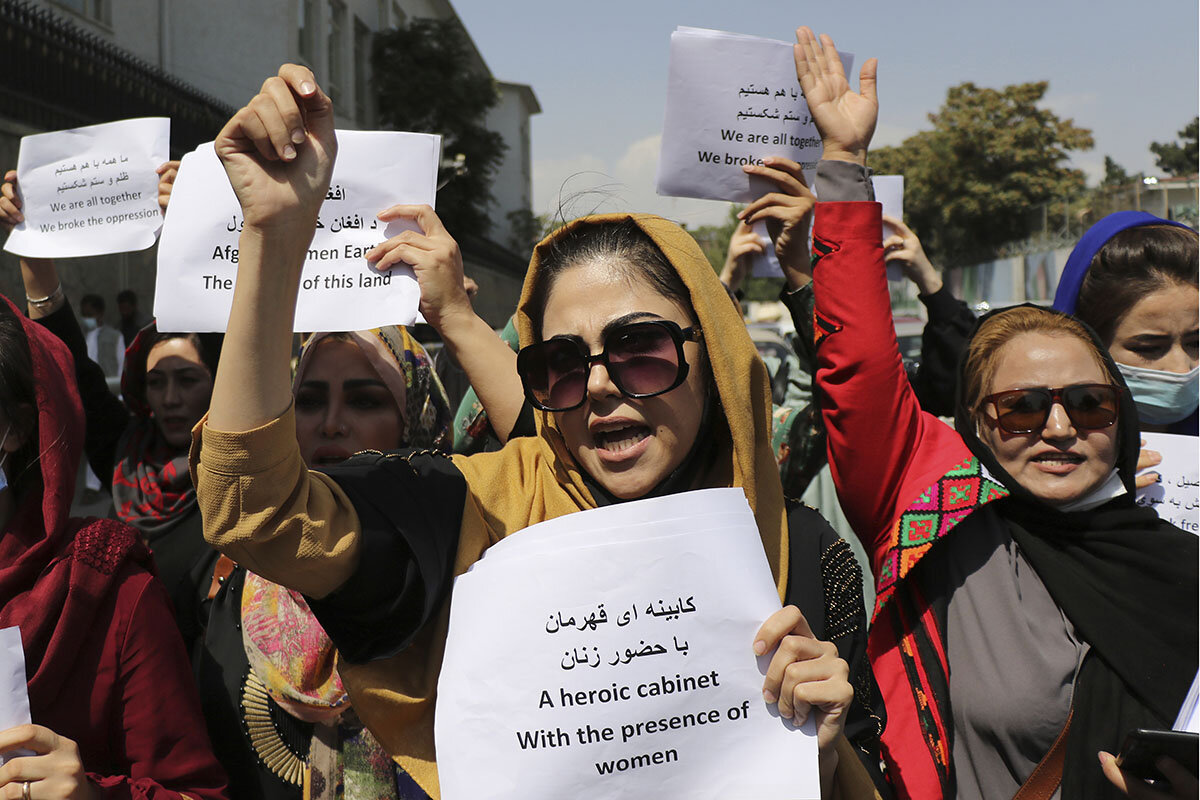
-
Ann Scott Tyson Staff writer
Over years of fighting, tens of thousands of Afghans have died. But Western intervention also improved lives for millions. Infant mortality plunged, life expectancy increased, literacy became more widespread, the GDP nearly tripled. Afghanistan developed a vibrant media, a noisy political scene, and an ever-growing awareness of civil rights.
Yet alarm is echoing across the country. Many Afghans see the hard-won progress of two decades jeopardized by a return to the heavy-handed rule of the archconservative Taliban, whose ranks include many who seem ill-prepared for the burden of governing.
The danger to women’s rights and the naming of an all-male, Taliban-only interim government have prompted days of protests in Kabul and other cities that have ended in violence. Taliban fighters – who boast of a victory over a superpower – have been flummoxed by women chanting the word “freedom,” disregarding guns pointed directly at them.
“Most Afghans didn’t want” the Taliban, says an Afghan administrator working for a foreign nonprofit in Kabul. “I am not sure if it means civil war, but it sure means people are not interested in just laying down and taking it. And there is a new generation of young people that is not scared of the Taliban.”
Afghanistan: Can social gains of last 20 years survive Taliban rule?
In a rugged valley on the eastern edge of Afghanistan, Gul Nasar has seen his village grow and prosper since a U.S.-led military invasion toppled the Taliban in 2001.
Yet he could not be more concerned today, about which of those gains – if any – encompassing education, health care, and the economy, will endure renewed Taliban rule.
As disappointment with the first taste of Taliban control seeps into Mr. Nasar’s village, manifestations of such alarm are echoing across Afghanistan.
Many Afghans see the hard-won progress of two decades jeopardized by a return to the heavy-handed rule of the archconservative jihadis, whose ranks include many who seem ill-prepared to take on the burden of governing.
The danger to women’s rights, the Taliban’s perennial dependence on Pakistan’s intelligence service, and the naming Tuesday of an all-male, Taliban-only interim government have prompted days of street protests in Kabul and other cities that have ended in gunfire and beatings.
“Most Afghans didn’t want [the Taliban]. We want to push back on this,” says an Afghan administrator working for a foreign nonprofit in Kabul, referring especially to sentiment among the urban, educated population.
“We are not going quietly on this one. I am not sure if it means civil war, but it sure means people are not interested in just laying down and taking it. And there is a new generation of young people that is not scared of the Taliban.”
Taliban fighters – who boast of a military victory over a superpower – have been flummoxed by Afghan women chanting the word “freedom,” disregarding guns pointed directly at them, and disobeying long-bearded fighters’ orders to disperse.
The new Afghanistan
The women’s steadfastness is just one element of the new Afghanistan.
“A lot happened in the last 20 years in terms of infrastructure, children’s education, and people having jobs,” Mr. Nasar says of his remote village, recalling how he and fellow villagers built a multiroom school with big blackboards, colorful carpets, and windows that let in sunlight. Girls at the school had their first lessons in reading, writing, and math.
A pharmacist arrived to run a newly built health clinic. And villagers struggling to live off their small fields of corn and wheat got government jobs – many with local security forces, which Mr. Nasar estimates brought $40,000 per month to the community.
“All of that is just gone,” says Mr. Nasar, who asked that a pseudonym be used to ensure his safety. The Taliban takeover means the school today has no teachers, the clinic no medicine, the local government no employees, and the villagers no more security force jobs.
Anger in the village is now setting in, says Mr. Nasar, after days of hiding in fear while the Taliban went joyriding in government trucks, leaving them banged up and out of gas on the side of the road.
“People are really disappointed how the Taliban handled things – they took an existing government and turned it into trash,” he says, scoffing that this generation of Taliban are “extremely uneducated people from the mountaintops.”
“There is no clear direction,” he adds, of the chaos. For the Taliban “it’s on-the-job training.”
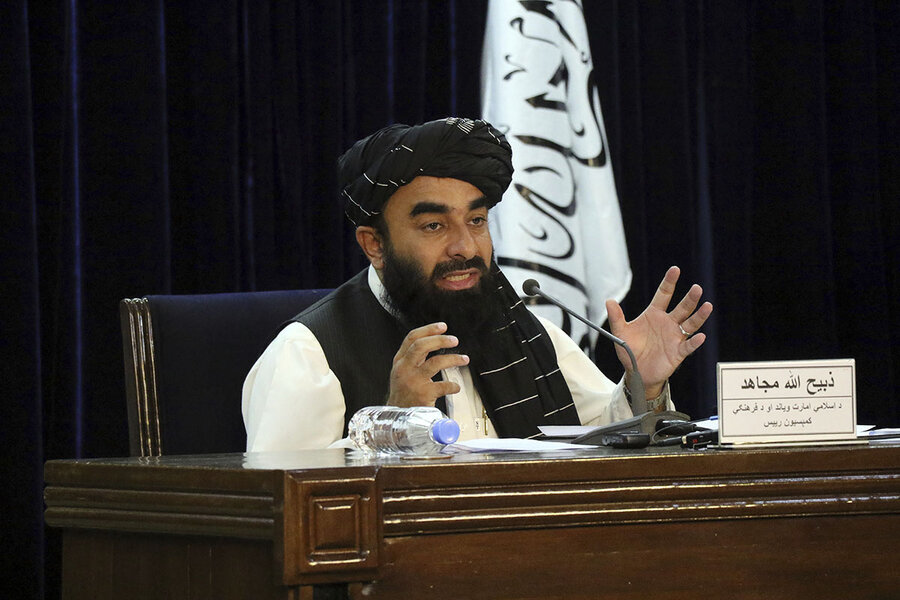
Across the country, Afghans are raising questions about the impact of the Taliban’s lightning takeover as U.S. and NATO troops completed their withdrawal.
Billions of dollars in American and other Western aid had yielded dramatic social and economic change, and raised expectations among a new generation of Afghans – factors that the Taliban are already struggling to contend with.
In a bid Wednesday to stop anti-Taliban protests, the acting interior minister – Sirajuddin Haqqani, who is on an FBI “terrorism” list, with a $10 million reward for information leading to his arrest – forbade “illegal” demonstrations.
“A different generation”
“Did you see the protests? Was this possible 20 years back?” asks Fawzia Koofi, a former deputy speaker of parliament.
Ms. Koofi, one of only two female members of the former government’s team at mostly unproductive peace talks in Qatar, was kept under house arrest in Kabul by Taliban guards for 10 days before Qatar negotiated her safe exit from Afghanistan.
“I have been telling the Taliban … that society has been transformed,” she says. “This is a different generation; they don’t let weapons and oppression govern over them. They will take the risk to their lives.
“This is a nation that will not go back, for sure,” says Ms. Koofi, who has survived two Taliban assassination attempts and aims to quickly return to Kabul.
Over years of fighting, tens of thousands of Afghans have died, most often at the hands of Taliban insurgents. And the former U.S.-backed government was renowned for corruption and weak governance.
But 20 years of Western intervention also improved lives for millions of Afghans. Infant mortality plunged by more than 50%, life expectancy grew by a decade, and overall gross domestic product nearly tripled. By 2017, literacy among young men had increased 28%, and among women by 19%, according to a U.S. government auditing agency.
Afghanistan had developed a vibrant media, a noisy political scene and all the trappings of a state, and an ever-growing awareness of civil and women’s rights.
So the learning curve has been steep for the Taliban, who readily admit they were not ready to take sole control and govern.
“Running a country is different from being in the mountains, running a group of 10 people,” says Ms. Koofi. “They are accountable now, but they are far from that,” she says. If “unprofessional [Taliban] members” are appointed to head institutions without consideration for “gender or ethnic, religious, and sectarian inclusion, I think it’s hard for those institutions to survive.”
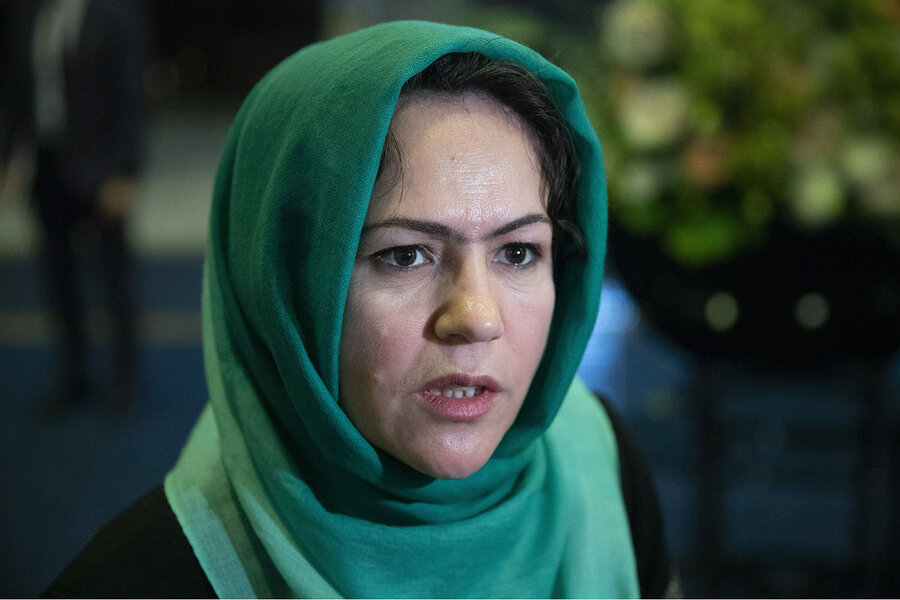
Indeed, the Taliban “showed little interest in running public services,” either during their rule from 1996 to 2001, or in areas under their control since then, according to a report this week by the Kabul-based Afghanistan Analysts Network. “It is unclear if they appreciate the full scale of the looming economic disaster,” it read.
Urgent needs
But time is short, as public services collapse, the economy melts down, and drought looms over one-third of the country.
This week, the United Nations launched an emergency appeal for $606 million, noting that even before the mid-August Taliban takeover – when virtually all donor funds to Afghanistan were frozen – some 18.4 million Afghans were in need of assistance. One-third of the population faced “crisis or emergency levels of food insecurity,” and the country “teeters on the brink of universal poverty.”
The World Health Organization warned, too, that the “backbone” of Afghanistan’s health care system is in danger, with the imminent closure of more than 2,000 health facilities, due to the funding pause.
Amid the turmoil, Afghans wonder how key social changes of the last 20 years will translate.
On girls’ education, forbidden outright by the Taliban 25 years ago, “the spectrum has slid,” says a Western analyst who asked not to be named while his organization evacuates staff from Afghanistan. “No one, even in the Taliban ranks, is gaining any traction by saying, ‘No education for girls, period.’”
The same may be true for health, after two decades that have seen fundamental gains, including for women saved during childbirth by legions of newly educated midwives.
“Everybody in Afghanistan, no matter how rural and remote they are, now believes that they do deserve, and have a right to, public health,” says the analyst.
“But guess what? The more conservative you get, the more important it is that the people providing health services to women are themselves women,” notes the analyst. “But where do those women doctors come from?”
First steps
The first signs are not encouraging. The Taliban this week reinstated its Ministry of Propagation of Virtue and Prevention of Vice, whose whip-wielding enforcers in the 1990s struck fear into the hearts of many Afghans, while apparently doing away with the Ministry of Women’s Affairs.
“They are not going to start making compromises to work with everyone else in Afghan civil society until they feel like they have eliminated threats,” says the analyst. But, of Taliban statements of moderation, he adds: “I’m inclined to believe it is not all just window dressing.”
The Taliban “have pulled off something that very few insurgencies, anywhere on the face of the earth in the last 100 years, have been able to manage,” he says. “And that speaks to a degree of sophistication and strategic thinking that tells me that they do understand that they can’t hold the entire country together through intimidation and beatings, and a secret police force.”
That would be good news to one out-of-work teacher of English and math at a private, coeducational school in Jalalabad, who asked that his name not be used for fear of retaliation. He remembers the intense focus on religious texts long ago, when he was a high school and university student under Taliban rule.
These days, economic uncertainty and hardship have kept students away from the many private schools and colleges that have sprung up since 2001, he says.
With his school now closed, he is working in his family’s shop, unsure whether he will teach again.
He hopes his expectations are wrong: “I am afraid that education will be going backward.”

In era of weather extremes, TV forecasters become climate educators
Weather forecasters didn’t use to talk much about climate change. Increasingly they are helping the public learn about the connection between climate science, extreme weather, and their own safety.

- Quick Read
- Deep Read ( 5 Min. )
Last week, as Hurricane Ida weakened on its way out of Louisiana, CBS News meteorologist Jeff Berardelli tweeted out a warning. “This is not getting the attention it deserves,” he wrote, alongside a graphic of the storm system traveling toward the Northeast.
The next morning, he took to the air to talk about how climate change was making weather events like Ida far more dangerous, putting the storms “on steroids.” Later that day, more than a half a foot of rain fell in the New York region over just a few hours. More than 45 people died in floodwaters.
What he did is part of a relatively recent trend. A decade ago, surveys showed that broadcast meteorologists, as a group, were more skeptical of climate change than the general public. But they’re moving closer in line with the attitudes of climate scientists overall.
“We’re seeing more and more broadcast meteorologists mention climate change and discuss how it’s impacting their local areas – the kinds of things that you would like to have the general public understand better,” says Keith Seitter, executive director of the American Meteorological Society. “They feel their viewers are seeing these changes. They are getting questions. You know, ‘Why is this happening?’”
In era of weather extremes, TV forecasters become climate educators

Last week, as Hurricane Ida weakened on its way out of Louisiana, CBS News meteorologist Jeff Berardelli tweeted out a warning.
“This is not getting the attention it deserves,” he wrote, alongside a graphic of the storm system traveling toward the Northeast. “Many people are going to wind up with water in their homes or worse.”
The next morning, he took to the air to talk about how climate change was making weather events like Ida far more dangerous, putting the storms “on steroids.” Later that day, more than a half a foot of rain fell in the New York region over just a few hours. More than 45 people died, many in cars or basements overcome by floodwaters.
“Climate change spikes these events nowadays, in a way that didn’t happen 20, 30 years ago,” Mr. Berardelli says.
For him, Ida was proof not only of a changing climate’s impact on weather. It was a reminder of the need for his profession to keep educating viewers about climate science – and to help them get out of harm’s way. This is an increasingly common view among broadcast meteorologists; a shift in approach and mindset that, along with changes in forecast technology and the way people get weather information, increasingly puts them at the intersection of extreme weather, public safety, climate science, and public trust.
“We’re seeing more and more broadcast meteorologists mention climate change and discuss how it’s impacting their local areas – the kinds of things that you would like to have the general public understand better,” says Keith Seitter, executive director of the American Meteorological Society. “They feel their viewers are seeing these changes. They are getting questions. You know, ‘Why is this happening’ ... questions that are making it easier for them to feel comfortable that they should be including [climate change] as part of what they’re talking about to their viewing audience.”
This is a relatively recent trend, say those in the industry. A decade ago, surveys showed that broadcast meteorologists, as a group, were more skeptical of climate change than the general public. But over recent years, according to research from Missouri State University and George Mason University, the percentage of those weathercasters concerned with climate change has increased rapidly, moving closer in line with the attitudes of climate scientists overall.

John Morales, a broadcast meteorologist in Miami, Florida, remembers when he was one of the few people in the industry talking about climate change – and when he had to resist pressure from bosses who would want to “balance” his reporting with comments from climate change deniers.
“I think things have evolved,” he says. “Over the past five or 10 years, news managers have realized, yeah, climate change is real, it’s here, it’s serious.”
“A profoundly local conversation”
At the same time, he says, meteorologists are increasingly comfortable making connections between climate change and the weather they’re seeing in their local areas.
“It’s really taken off of late for them to give climate context on air,” Mr. Morales says. “It’s much more so today than, gosh, even two or three years ago.”
That perception is backed up by research. Edward Maibach, director of George Mason’s Center for Climate Change Communication, says climate reporting by television weathercasters is up some sixtyfold today compared with seven years ago.
And this, according to some studies, has an impact.
While there is conflicting research about whether extreme weather events change Americans’ views about climate change, George Mason’s Center for Climate Change Communication found that when broadcast weathercasters make the connection, people are more likely to shift their views.
In an experiment published in 2020, researchers compared viewers’ reactions to different types of weather reports in the Chicago and Miami television markets. Viewers who saw reports that made connections to climate change were more likely to worry about climate change, believe it was happening, and also want to take action to address it. That was true even for Republican viewers, who tend to be more skeptical of global warming.
“It’s very helpful when a trusted local TV meteorologist educates his or her viewers about how global climate change is changing conditions in our community,” says Dr. Maibach. “It’s a whole different conversation when a local TV meteorologist does it. Meteorologists aren’t seen as political. … It’s a profoundly local conversation. It provokes a different way of processing the conversation.”
In 2010, the climate science research group Climate Central created the Climate Matters program to help create and distribute climate science content to broadcast weather forecasters. Over the past decade, it has expanded from one pilot project in South Carolina to include more than 1,000 weathercasters across the country, says Bernadette Woods Placky, a former television meteorologist who now directs the program.
“There’s a heightened interest in what’s going on,” she says. “More people are listening, more people have questions. And think about it, when your house is washed away, or your car is washed away, you’re looking at the world differently.”
There are some skeptics, though. Jon Krosnick, director of the Political Policy Research Group at Stanford University, says his research has shown broadcast meteorologists have minimal effect on people’s views about climate change.
Indeed, Dr. Krosnick says, very little changes views on climate change at all – including the extreme weather events of this past year. According to his research, more than 80% of Americans already believe in human-caused global warming, and some 60% already want the government to do more about it. Those numbers are no different now than they were a year ago, he says, before the country’s recent widespread heat waves and flooding events, and before a United Nations’ Intergovernmental Panel on Climate Change report explicitly tied extreme weather to climate change.
“These efforts at persuading American citizens about the existence of climate change, about the causes of climate change, about the seriousness or threat of climate change – all of that stuff is what magicians call misdirection,” he says. “It’s working on a problem that doesn’t exist.”
New forecasting capabilities
But for many in the meteorological community, convincing people about climate change is less about advocacy than it is about what they say is the underlying mission of broadcast weathercasters: keeping people safe.
Along with a growing familiarity with climate science, says Mr. Morales, weathercasters as a group are connecting to rapidly advancing forecasting technology – computing tools that can help pinpoint everything from the local impact of a storm to the likelihood that it will evolve into a disaster amplified by climate change.
“The way that forecasts are built these days are just so radically different than the way they were built five, 10 years ago,” he says.
Brenda Ekwurzal, director of climate at the Union of Concerned Scientists, says that meteorologists are exploring new uses for weather apps, including ways to share the best evacuation routes away from a hurricane.
And it was weather buoys in the Gulf of Mexico, she adds, that revealed the warm water in Ida’s path – a situation meteorologists across the country knew would likely make the storm far more ferocious.
“It’s really, really important that the data is there, that it’s becoming available,” she says. “Meteorologists have the hard job of telling people that there’s a risk.”

When is marriage child abuse? Shifting attitudes bring reforms.
The modern idea of marriage is built on a foundation of love and partnership. Increasingly, states are rethinking how young is too young to enter into such a contract, as advocates lobby lawmakers to close child marriage loopholes.

- Quick Read
- Deep Read ( 5 Min. )
-
By Cathryn J. Prince Correspondent
Forty-four states allow some form of underage marriage in the United States. But last month, North Carolina joined a growing movement to legislate reforms meant to curb child marriages, and protect the young people – mostly girls – who are victimized by them.
“Some people romanticize the idea of young people getting married. It’s not [romantic]. In fact the U.S. State Department has called marriage under 18 a human rights abuse,” says Fraidy Reiss, founder and executive director of Unchained at Last, a nonprofit aimed at ending child marriage for good.
The shift in thinking about this issue started gaining traction in 2015 when the United Nations formed Girls Not Brides, a global partnership with the goal of ending child marriage worldwide by 2030. Since then, advocacy groups in the U.S. have worked to persuade state legislatures to end what they describe as America’s “marriage problem.”
“There is definitely a bit of American exceptionalism when it comes to the issue – the idea that it happens in other countries, but not here,” says Max Robins, an American University student who started the group Students Against Child Marriage. “However, once there is an awareness about it, it’s a bipartisan subject that legislators can get behind.”
When is marriage child abuse? Shifting attitudes bring reforms.

When Democratic Gov. Roy Cooper of North Carolina signed a law last month raising the age of marriage from 14 to 16 years old, those seeking an end to child marriage didn’t exactly celebrate.
“It’s a positive step. It’s better than nothing,” says Antonia Kirkland, global lead for legal equality at Equality Now, a nonprofit working to achieve legal systemic change to end violence and discrimination against women worldwide.
If her response was muted, it’s because children can still get married in North Carolina and because only six states nationwide outlaw marriage before age 18 with no exceptions. Still, advocates like Ms. Kirkland are hopeful that the law signifies changing attitudes regarding the differences between childhood and adulthood – legally, emotionally, and physically.
The shift in thinking about this issue started gaining traction in 2015 when the United Nations’ sustainable development goals led to Girls Not Brides, a global partnership with the goal of ending child marriage worldwide by 2030. Since then, advocacy groups in the United States have worked to persuade state legislatures to end what they describe as America’s “marriage problem.”
“People are more aware that it’s really harmful to be married before the age of 18, not just globally, but in the United States. Girls should be girls, not brides,” Ms. Kirkland says, echoing the U.N.’s call to action.
Nationwide, more than 200,000 minors were estimated to have been legally married between 2000 and 2018, according to a study by Unchained at Last, a nonprofit pushing to end child marriage in the U.S. The majority of those were girls married to adult men who were significantly older. Precise numbers aren’t available since data was only available from 41 states, according to an August 2020 International Research on Women report.
And while the number of child marriages nationwide decreased sharply during the 18-year span of Unchained’s study – there were an estimated 76,396 in 2000 and 2,493 in 2018 – the goal should be zero, argues Fraidy Reiss, founder and executive director of Unchained at Last.
Although many picture two teens eager to begin their lives together on equal footing, the reality is that many of these marriages involve young girls and much older men. “It’s not [romantic],” Ms. Reiss says. ”In fact the U.S. State Department has called marriage under 18 a human rights abuse.”
The persistence of forced marriage
Ms. Reiss’ own experience inspired her to launch Unchained in 2011. Raised in an ultra-Orthodox Jewish community in Brooklyn, Ms. Reiss was 19 when her parents forced her to marry a man several years her senior, who, she says, turned out to be violent. Ms. Reiss fled the marriage 12 years later and eventually divorced him and left the Hasidic community.
After graduating from Rutgers with a degree in journalism, Ms. Reiss began working with women who, too, were trying to flee forced marriages.
One view enshrined in many state laws is that, in some cases, marriage is appropriate for people under 18 if their decision is vetted by their parents, the courts, and in some cases both. As Ms. Reiss researched the issue, she concluded a year into her work that the only way to end forced marriages, many of which involved underage girls, was to advocate for a firm age limit.
Aside from meeting with lawmakers and traveling the country to raise awareness about child marriage, Ms. Reiss and other supporters of Unchained at Last will frequently protest in front of statehouses dressed in bridal gowns and veils, with chains around their wrists.
There are signs the movement is having an impact.
Since Delaware became the first state to outlaw marriage under the age of 18, with no exceptions, in 2018, another 25 states have strengthened laws about the minimum age of marriage, according to the Tahirih Justice Center. Kansas, Michigan, and Maine are among several other states with pending legislation that would ban all marriages before age 18.
The shift among state lawmakers includes an awareness that if minors wed, they often face devastating economic, educational, physical, and emotional consequences.

Girls or young women who marry before age 19 are 50% more likely to drop out of high school and only 25% as likely to complete college, according to Unchained. Additionally, girls who marry before they turn 16 are about 31% more likely to end up in poverty, and they face serious health risks, including death due to early and closely spaced pregnancies.
Young people under age 18 have few legal rights. As more than one expert explained, minors can’t enter contracts, they can’t hire a lawyer, they can’t go to shelters if the marriage is abusive, and in some states police will treat married girls as runaways and return them to homes they are trying to escape.
A shifting patchwork in state laws
In July, New York became the sixth state to raise the age of consent for marriage to 18, without exceptions.
Even some states with high rates of child marriage – such as Nevada, Arkansas, Kentucky, Utah, and Mississippi – have tightened their laws. For example, in Utah, children could once marry as young as age 16 with parental consent and as young as 15 with both parental and judicial consent. In 2019 that was changed so 16- and 17-year-olds could marry only if they had both parental and judicial consent.
Not all states are embracing stricter legislation, or at least not quickly. In some states, there is support but it’s not a legislative priority. In other states, such as California and Louisiana, some lawmakers and groups like the American Civil Liberties Union maintain that it’s government overreach to decide age appropriateness when it comes to marriage. Still others have argued that it’s unnecessary to raise the marriage age to 18 since there are already existing laws that protect girls from exploitation.
But according to Lisa Jean Moore, a sociology and gender studies professor at Purchase College in New York, throughout history norms of marriage – including child marriage – have commonly emerged from patriarchal systems that viewed women and girls as little more than property.
“There is also a culture of vast sexual exploitation of children in the country,” says Ms. Moore, “and lawmakers can look at this [allowing for child marriage] as a twisted way of protecting girls.”
The laws are “twisted,” as Ms. Moore and other proponents of ending the practice say, because they can be used to force young victims of rape who become pregnant to marry their adult perpetrators. Additionally, child marriage subjects minors to state-sanctioned statutory rape. According to federal law, it is a defense for the crime of statutory rape of a minor under age 16 if the people are married to each other.
“They are ‘get out of jail free’ laws,” says Max Robins, founder and executive director of the nonprofit Students Against Child Marriage.
A double major in political and data science, the American University student first learned about the issue back in 2017 when he read about it in a national newspaper.
The nonprofit has grown quickly since its launch in 2019. Today, with chapters at universities and high schools across the country, it teams up with other advocacy groups like Unchained to convince legislators to change marriage laws.
“There is definitely a bit of American exceptionalism when it comes to the issue – the idea that it happens in other countries, but not here,” says Mr. Robins. “However, once there is an awareness about it, it’s a bipartisan subject that legislators can get behind.”

Essay
Titian paintings reunite after 450 years. How receptive are museumgoers?
Where does viewing art fit among our other attention-demanding options? In Boston, a rare exhibition of Renaissance paintings tests the appeal of quiet contemplation.
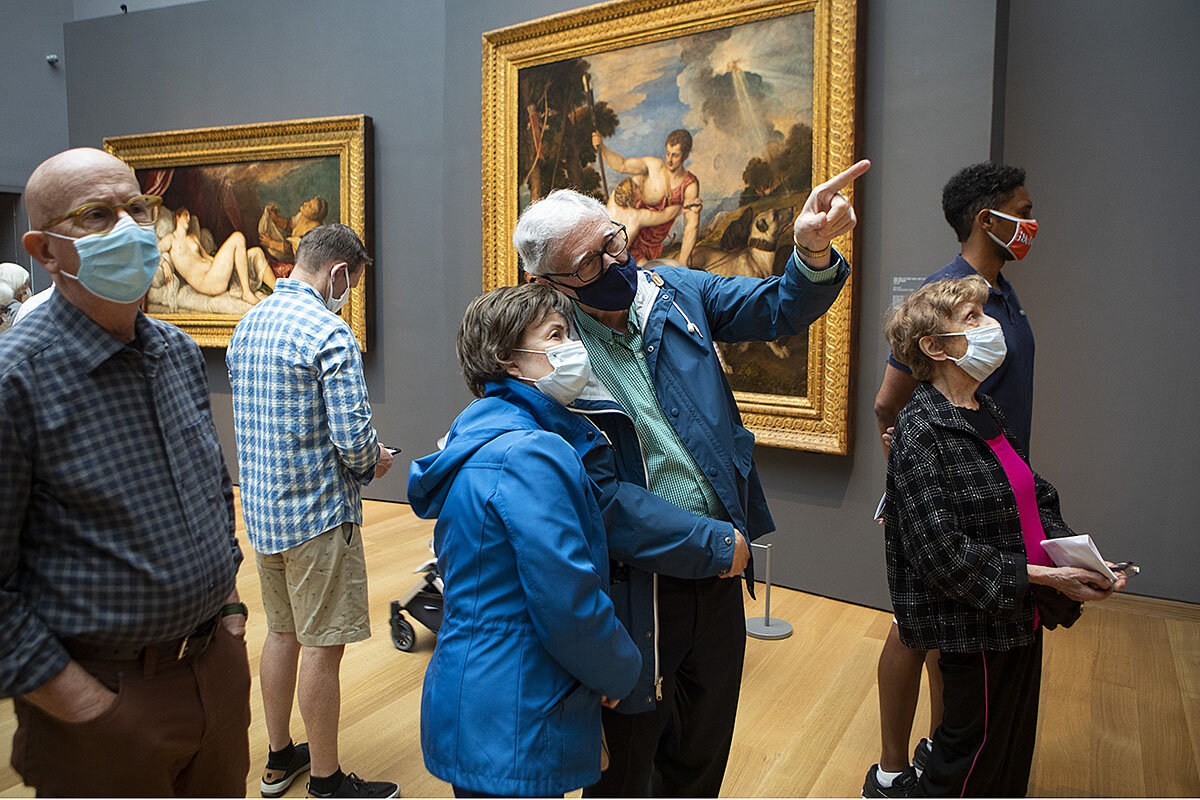
- Quick Read
- Deep Read ( 6 Min. )
When Titian created six masterpieces for King Philip II of Spain centuries ago, the Renaissance artist pioneered a revolutionary style in a bid for primacy against other art forms.
“It’s not hyperbole to say that these paintings transformed the history of Western painting,” says Nathaniel Silver, curator of the Isabella Stewart Gardner Museum in Boston, which recently opened an exhibit reuniting the group.
Viewing these works more than 450 years later, it occurred to me that Titian has to compete, yet again, with other art forms. This time he’s vying for attention against youthful mediums such as TikTok. Many of today’s leisure options consist of digital content that’s interactive and immediately available. By contrast, Titian’s canvases are stationary and require a visit to view them. A more fundamental question is whether Titian’s mythological scenes, which depict sexual violence with a prurient gaze, speak to our contemporary values.
Then again, the exhibition makes a compelling counter argument for quiet contemplation about the arc of human history. Taken on those terms, Titian’s paintings still hold their own against contemporary art forms. The Gardner’s innovative presentation, which incorporates the perspective of modern social mores, suggests that museums can still find a niche for our attention.
Titian paintings reunite after 450 years. How receptive are museumgoers?
What would the great artist Titian have thought of TikTok? I pondered that question when I visited the landmark exhibition “Titian: Women, Myth & Power” at the Isabella Stewart Gardner Museum.
For most of Titian’s life, which paralleled the crest of the Renaissance period, painting was overshadowed by other artistic mediums. The printing press had elevated the popularity of drama and poetry, which was sometimes accompanied by music. So when Titian created six masterpieces for King Philip II of Spain – reunited for the first time in several centuries in this exhibition – the artist pioneered a revolutionary style in a bid for primacy against other art forms. The Italian broke with finely detailed techniques of the era for looser, impressionistic brushstrokes that invited one’s eye to fill in the specifics.
“It’s not hyperbole to say that these paintings transformed the history of Western painting,” Nathaniel Silver, curator of The Isabella Stewart Gardner Museum, tells me.
Viewing these works more than 450 years later, it occurred to me that Titian has to compete, yet again, with other art forms. This time he’s vying for our attention against youthful mediums such as TikTok and video games. Many of today’s leisure options consist of hi-def digital content that’s immersive, interactive, and immediately available to our scrolling fingertips. By contrast, Titian’s slabs of oil and canvas are stationary, two-dimensional, and require a visit to view them in person. A more fundamental question is whether Titian’s mythological scenes, which depict sexual violence with a prurient gaze, speak to our contemporary values.

Then again, the exhibition makes a compelling counter argument for quiet contemplation about the arc of human history. Taken on those terms, Titian’s paintings still hold their own against contemporary art forms. The Gardner’s innovative presentation, which incorporates the perspective of modern social mores, suggests that museums can still find a niche for our attention.
“Museums are in a really interesting space because they still have this cachet of being the symbol of authority,” says Ben Davis, national art critic at Artnet News, an online publication. “But at the same time, they are just this really small node in this giant information network that everybody’s consuming now.”
Museums can stand out by being a little out of step with popular culture, says Mr. Davis, but he adds that there’s great pressure on museum directors to cater to what’s fashionable.
“Titian: Women, Myth & Power” isn’t necessarily hip – when was the last time the Renaissance Art was chic? – but it is a blockbuster show. Several of these paintings have never traveled outside of Europe. The Gardner Museum, which owns Titian’s greatest work, “The Rape of Europa” (1559-1562), is the sole American venue for the traveling exhibition, which runs through January 2. The Italian artist’s six “poesie,” or painted poems, inspired by the work of Roman poet Ovid, were initially displayed in Philip II’s palace in Madrid. Then they wound up in different collections. Each of these paintings are the equivalent of hit singles. Viewed together again at last, it’s apparent that they form a classic album.

The show has been billed as a one-off reunion, likely never to be repeated. But nowadays, people are pulled in so many directions for entertainment – and life – that they are often hard-pressed to find time to visit museums. (And some people are still hesitant to visit crowded indoor spaces due to the pandemic.) That’s why The Boston Globe’s rave review of the exhibition pleaded with readers to make the effort to go, calling it “an extreme lesson in the value of showing up.” Visitors to the Titian display echo that sentiment.
“You see the scope of the painting, the largeness of it, which doesn’t really come across from a book that I’ve seen or any online representation,” says David Jackson from Chicago, visiting the museum with his brother, Steven. “The subtlety of the colors really comes out when you see it in person. Also the atmosphere of all these people circling around, looking at it, adds something to the experience. It’s something that touches people.”
During my two visits to the exhibition, there were waiting lines outside. Yet teenage attendees were as scarce as fully clothed females in Titian’s paintings. The Gardner has made a concerted effort to speak to younger generations by offering companion exhibits with a social justice perspective.

A short film, “The Rape of Europa” by Mary Reid Kelley and Patrick Kelley, delivers a feminist critique via risqué limericks that would have made even Chaucer blush. Visitors can also scan QR codes with their cellphones to listen to audio commentaries by contemporary artists responding to Titian’s representation of women, nonconsensual sex, and patriarchal power. (It’s an ingenious way to engage visitors so they’re not distracted by other apps on their phone.) For instance, Matisse DuPont, a transgender educator, artist, and consultant, shares an LGBTQ interpretation of “Diana and Actaeon.” Artist Johnette Marie Ellis explores a white savior complex in “Perseus and Andromeda,” wondering why an Ethiopian princess is rescued by “a semblance of a man of Greece.”
Mr. Silver, the curator, says that The Washington Post’s rave review of the exhibition – with art critic Sebastian Smee raising the idea that it is “the art event of the year, and possibly the decade” – attracted hundreds of comments by readers. There was a raging argument between those who appreciated the commentary by contemporary artists in the show and those who loathed their inclusion.
“I go to conferences as a scholar all the time where people will tell you that the Renaissance is dead,” says Mr. Silver. “I can’t think of a contemporary art exhibition that generates this much discussion and debate. And to me, that suggests that the Renaissance and the old master paintings are a lot more relevant and engaging to people than most specialists would have you believe.”
During one of my visits to the exhibition, I overheard a teenager explain to her mother that some women in the paintings wear their curly blonde hair up so they’re less sexually provocative to men. (Titian only grants them that modicum of modesty – they’re all naked.) Turns out that teen, Elena Comellas, a student at Wellesley College from Puerto Rico, recently visited Greece to study classics. I asked her why so few of her peers have attended this exhibition.
“I think it’s because of social media and because there’s so many distractions nowadays that people aren’t looking towards art,” she said. “There’s so many other things that are available and maybe more interesting to them.”
Indeed, a new Deloitte survey of Generation Z consumers found that 26% favor video games as their favorite pastime. Next on the list came music at 14%, followed by browsing the internet (12%), and interactions on social platforms (11%). Watching movies or television shows ranked even lower. As for visiting art museums? To borrow a Gen Z slang term, that’s just cheugy (translation: passé).
But the anxiety and depression among young people, often linked to social media, presents an opportunity, says Mr. Davis, the art critic. Savvy museums could ally themselves with the growing mindfulness and meditation movement.

“The first museums were really supposed to be spaces of solace in the face of new industrialization,” says Mr. Davis. “Its slowness, things that people find that are making it a tough sell in a digital economy, might actually be strengths. These are repositories of slower forms of looking and attention and historical thinking.”
The Gardner museum, which boasts a serene indoor atrium, certainly invites quiet contemplation. Inside the intimate Hostetter Gallery, one can grapple with the complexities and contradictions in Titian’s compositions. His scenes of anguished violence often feature a lascivious gaze. But there’s also great humanity in the tenderness and compassion of many of the characters.
Another thing I noticed: The grandeur of these paintings easily commands visitors’ attention for long periods of time. Student Farid Mazrui from Buffalo, New York, says Titian’s “breathtaking” work makes him want to learn more about classic mythology. The mathematics major adds that he valued being around other people in a quiet environment.
“It’s healthy to disconnect, you know, just turning your phone off for an hour and you come to experience it,” Mr. Mazrui tells me. “It makes you live in the moment.”

In Pictures
9/11 in pictures: A day of eerie quiet, sadness, solidarity
Looking back on 9/11, it’s easy to remember the horror and the grief. But our photographer’s collection of images from the weeks following those attacks reminds us of the selflessness and love that also poured forth.
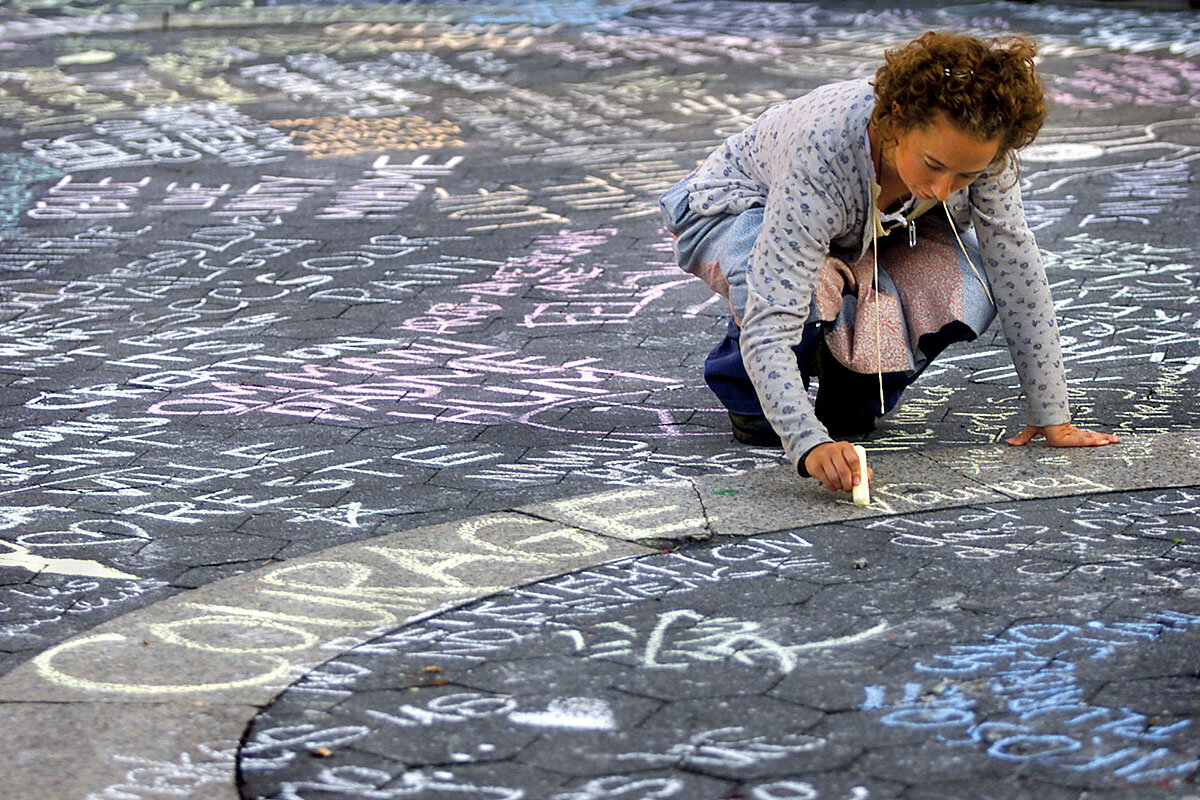
- Quick Read
- Deep Read ( 3 Min. )
Sept. 11, 2001, started as a routine day at the office, but turned into the hardest assignment I’ve ever covered.
I drove down to New York that evening on highways empty of traffic except for first responders and utility trucks loaded with flood lights. My press pass got me onto the island of Manhattan, where all roads and bridges leading into the city were closed. It was eerily quiet, no cars and no pedestrians. For the next two weeks I walked the city, photographing people and places forever changed.
I’ve been to war zones far overseas, but never something like this in my own backyard. Still, as in most extreme situations, goodness shone through.
One night, sitting spent in the back of a taxi after a long day of photographing, I saw a small group on a street corner holding a candlelight vigil. I asked the driver to stop and went over to join them. They were Spanish speakers, immigrants, sharing prayers, holding American flags. “Please,” one of them asked, “can you help us sing that song, ‘O say can you see’?” They didn’t know the words. I put down my cameras and together we sang – or hummed – the national anthem. It was beautiful.
Click the “deep read” button above to view Melanie’s photographs.
9/11 in pictures: A day of eerie quiet, sadness, solidarity
Sept. 11, 2001, started as a routine day at the office, but turned into the hardest assignment I’ve ever covered – from Boston, where the two planes that hit the World Trade Center towers originated, to New York, a city in shock.
I drove down to New York that evening on highways empty of traffic except for first responders and utility trucks loaded with flood lights. My press pass got me onto the island of Manhattan, where all roads and bridges leading into the city were closed. It was eerily quiet, no cars and no pedestrians. For the next two weeks I walked the city, photographing people and places forever changed. I’ve never walked so much. I’ve never been so physically and emotionally drained.
The smell of ash and smoke, of destruction, filled my nose and mouth. I couldn’t photograph ground zero itself – media access was severely restricted – so I photographed around the perimeter. I took pictures of exhausted, soot-covered firefighters walking out after their shifts ended; message boards with photos of the missing – Have you seen my mother? brother? son?; chalked words of inspiration that bloomed on the pavement at Union Square. People were kind, courteous, generous.
I’ve been to war zones far overseas, but never something like this in my own backyard. Still, as in most extreme situations, goodness shone through.
One night, sitting spent in the back of a taxi after a long day of photographing, I saw a small group on a street corner holding a candlelight vigil. I asked the driver to stop and went over to join them. They were Spanish speakers, immigrants, sharing prayers, holding American flags. “Please,” one of them asked, “can you help us sing that song, ‘O say can you see’?” They didn’t know the words. I put down my cameras and together we sang – or hummed – the national anthem. It was beautiful.









Other headline stories we’re watching
(Get live updates throughout the day.)The Monitor's View
When enemies aren’t enemies for Biden
- Quick Read
- Deep Read ( 2 Min. )
-
By the Monitor's Editorial Board
President Joe Biden says the United States is in “extreme” competition with China – even to the point of clashes at sea between their navies. Yet on Thursday he spoke by phone with Chinese leader Xi Jinping, the second time they have talked since Mr. Biden took office.
The phone chats fit a pattern for Mr. Biden. He prefers to talk to geopolitical rivals of the U.S., listening to their grievances and interests without necessarily embracing them.
“It’s always better to meet face-to-face,” Mr. Biden said at his first major overseas summit in June with Russian President Vladimir Putin.
Also in June, he offered to reopen negotiations with North Korea “without preconditions.” The Biden team has held five indirect talks with Iran. In August, CIA Director William Burns met secretly with Taliban leader Abdul Ghani Baradar.
When adversaries do agree to negotiate with Mr. Biden, he also makes a point to thank them. As scholar Arthur C. Brooks wrote in his 2019 book, “Love Your Enemies,” expressing gratitude for those who disagree with you is a “contempt killer.” It helps separate the actions of adversaries from the persons themselves. Then a dialogue across differences can more easily begin.
When enemies aren’t enemies for Biden
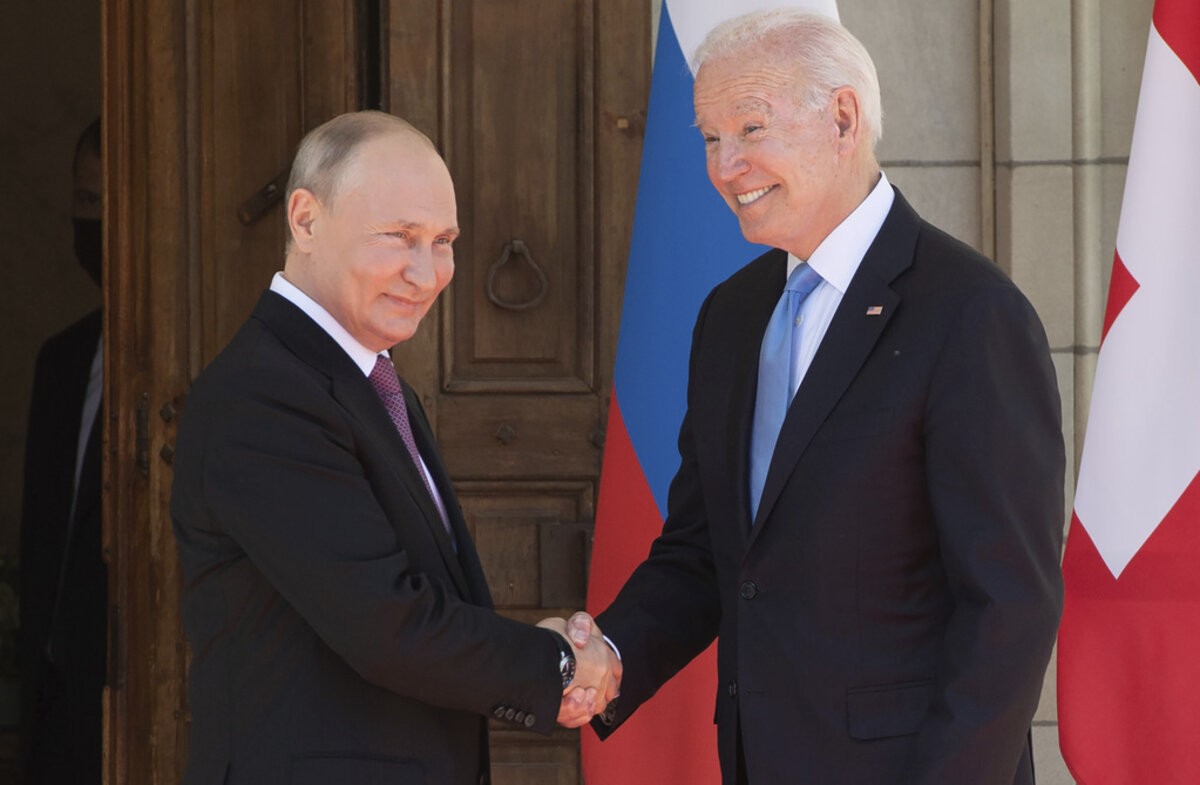
President Joe Biden says the United States is in “extreme” competition with China – even to the point of clashes at sea between their navies. Yet on Thursday he spoke by phone with Chinese leader Xi Jinping, the second time they have talked since Mr. Biden took office. The two presidents may finally meet in person this fall at a multilateral summit.
The phone chats fit a pattern for Mr. Biden. He prefers to talk to geopolitical rivals of the U.S., listening to their grievances and interests without necessarily embracing them. Like President Barack Obama, he seems to believe that denying communication with adversaries should not be considered as punishment.
“It’s always better to meet face-to-face,” Mr. Biden said at his first major overseas summit in June with Russian President Vladimir Putin. “It’s just pure business.”
Also in June, he offered to reopen negotiations with North Korea “without preconditions.” While the offer was refused, Mr. Biden supports South Korea’s attempts for talks with Pyongyang.
Since coming into office in January, the Biden team has also held five indirect talks with Iran in hopes of reviving a 2015 deal that curbed its nuclear program. (In 2018, President Donald Trump withdrew the U.S. from the pact.) Iran has not resumed the indirect talks since Aug. 5 when a hard-line president, Ebrahim Raisi, took office. Nonetheless, U.S. envoys keep in touch with Iran through other countries, such as Qatar.
The Biden administration’s most unusual high-level negotiation with an adversary came in late August. CIA Director William Burns met secretly with Taliban leader Abdul Ghani Baradar in Kabul, Afghanistan. Their talks led to safe evacuations of U.S. citizens and Afghan allies.
During his decades in the Senate, Mr. Biden showed a patience and a willingness to talk to political opponents. That display of respect helped him build up enough trust to open doors for difficult concessions on legislation.
When adversaries do agree to negotiate with Mr. Biden, he also makes a point to thank them. As scholar Arthur C. Brooks wrote in his 2019 book, “Love Your Enemies,” expressing gratitude for those who disagree with you is a “contempt killer.” It helps separate the actions of adversaries from the persons themselves. Then a dialogue across differences can more easily begin.

A Christian Science Perspective
Each weekday, the Monitor includes one clearly labeled religious article offering spiritual insight on contemporary issues, including the news. The publication – in its various forms – is produced for anyone who cares about the progress of the human endeavor around the world and seeks news reported with compassion, intelligence, and an essentially constructive lens. For many, that caring has religious roots. For many, it does not. The Monitor has always embraced both audiences. The Monitor is owned by a church – The First Church of Christ, Scientist, in Boston – whose founder was concerned with both the state of the world and the quality of available news.
After hard times, a new birth
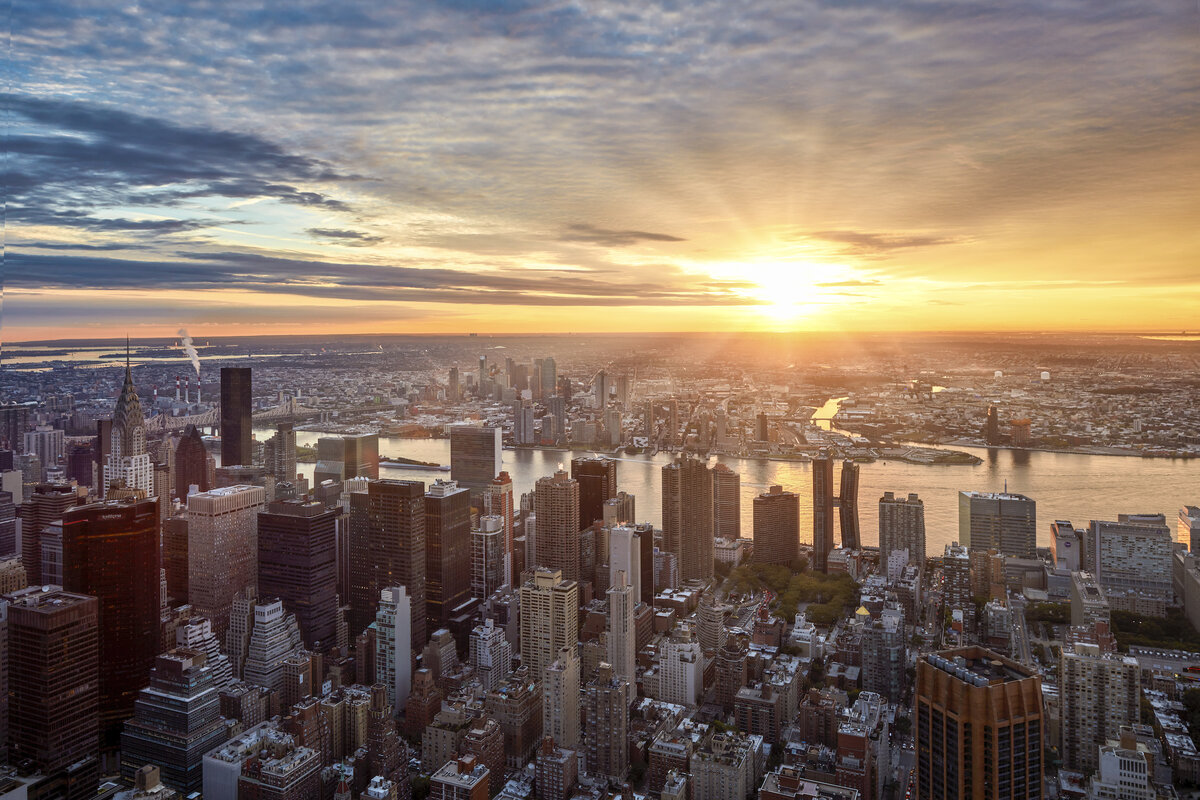
- Quick Read
- Read or Listen ( 1 Min. )
When tragedy – or the memory of past tragedy – strikes, picking up the pieces of hearts, minds, and lives can seem an overwhelming task. But opening our hearts to God’s love is a powerful starting point for a new birth, one that includes lasting healing and peace.
After hard times, a new birth
Behold, I make all things new.
– Revelation 21:5
Let us feel the divine energy of Spirit, bringing us into newness of life and recognizing no mortal nor material power as able to destroy. Let us rejoice that we are subject to the divine “powers that be.”
– Mary Baker Eddy, “Science and Health with Key to the Scriptures,” p. 249
The new birth is not the work of a moment. It begins with moments, and goes on with years; moments of surrender to God, of childlike trust and joyful adoption of good; moments of self-abnegation, self-consecration, heaven-born hope, and spiritual love.
– Mary Baker Eddy, “Miscellaneous Writings 1883-1896,” p. 15
For more inspiration on this theme, check out "A new birth after hard times," a 9/11 reflection in the Christian Science Sentinel, a sister publication of the Monitor.

A message of love
To market
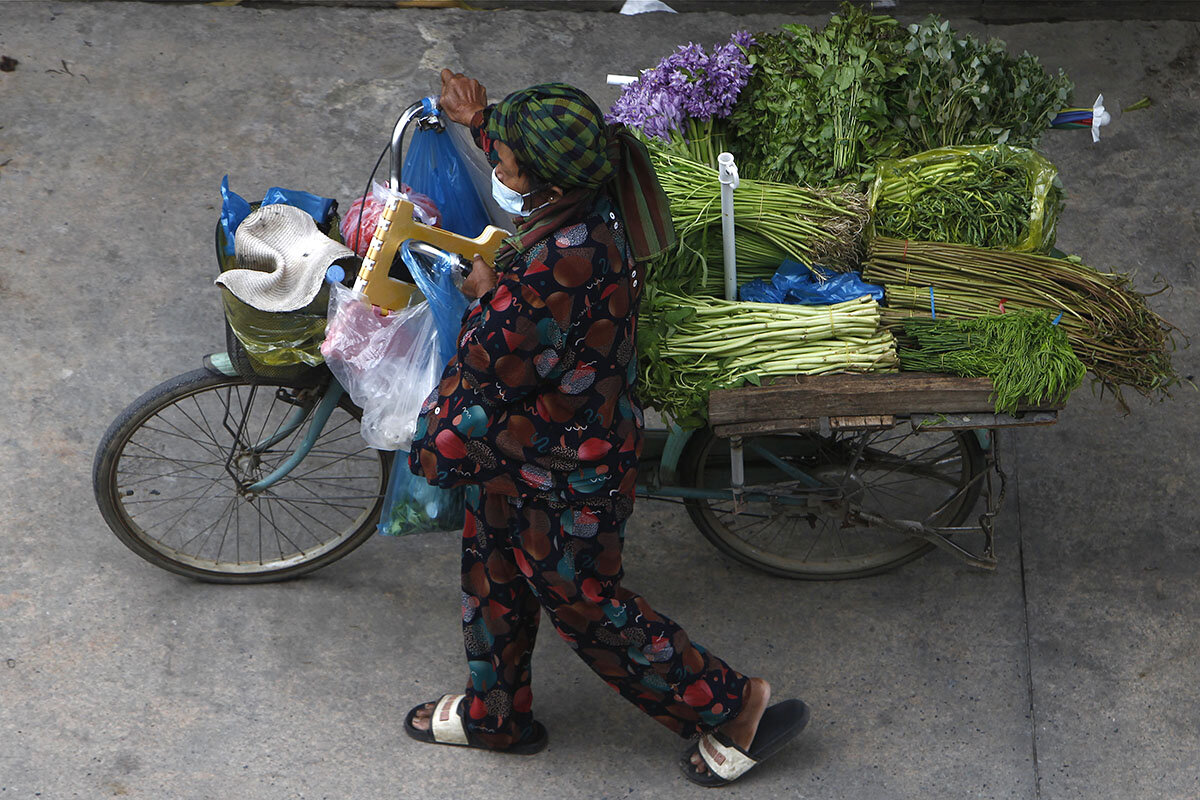
A look ahead
Thank you for joining us. Please come back Monday, when staff writer Francine Kiefer examines the history behind California’s recall.
With President Biden’s Thursday announcement implementing new vaccine requirements for federal workers and large companies, we thought it would be useful to look back at our April explainer on vaccine passports. As we reported then, the law is clear. The ethics are not.




